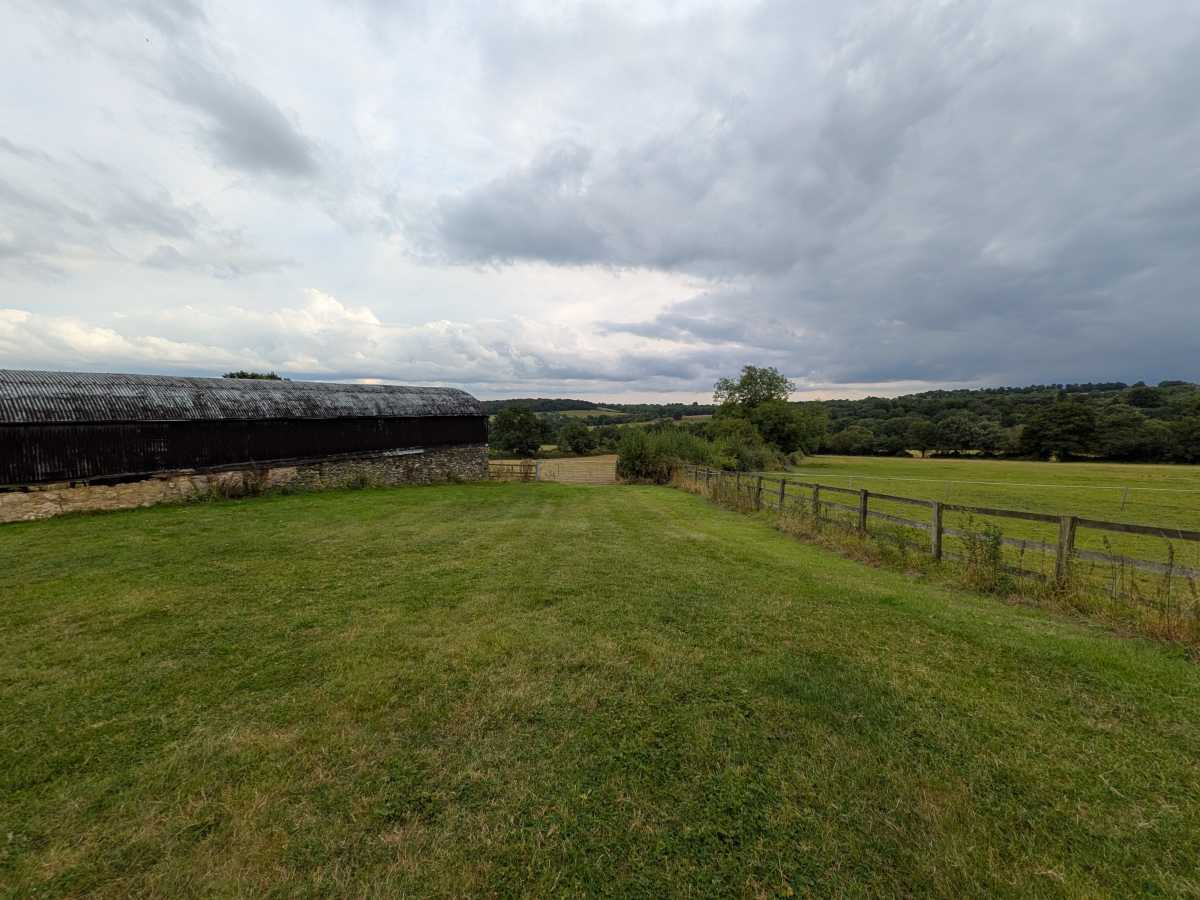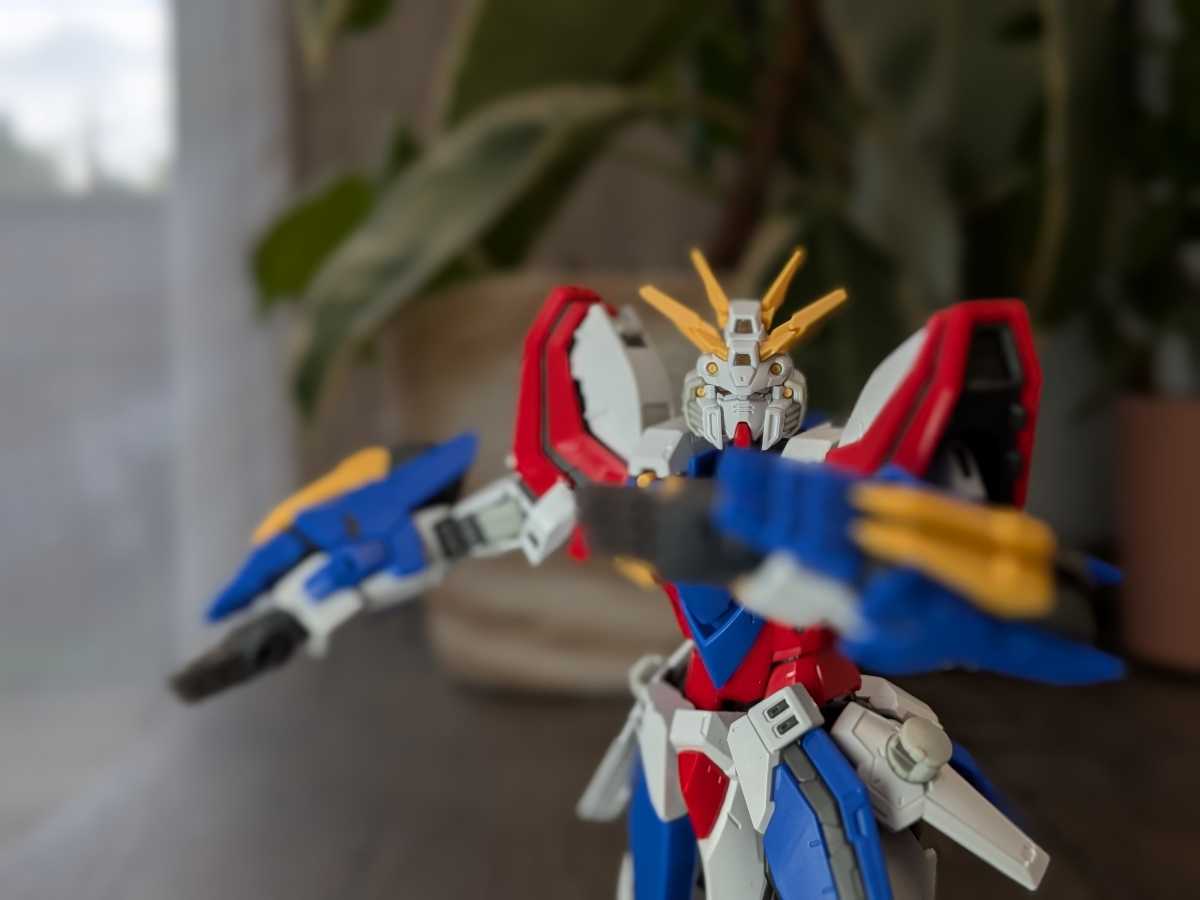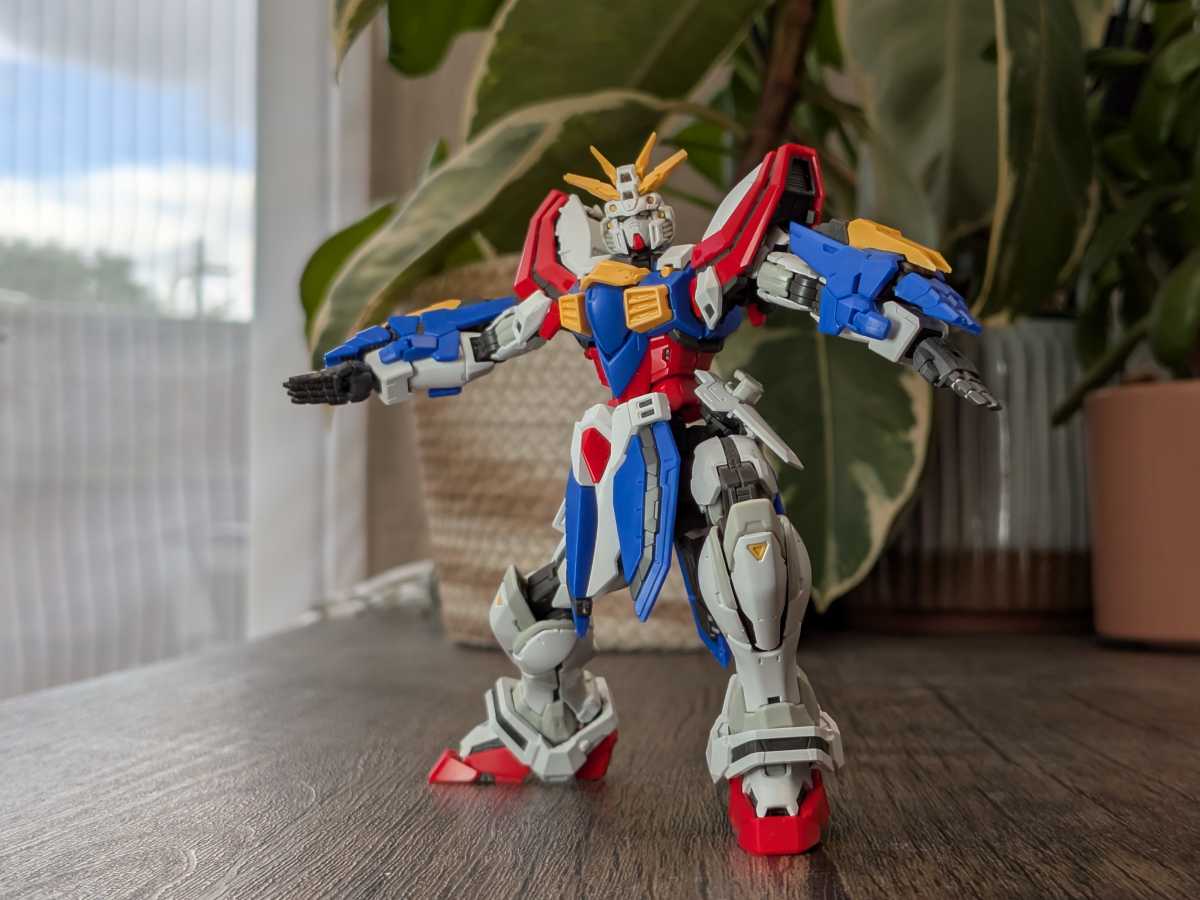Expert's Rating
Pros
- Premium look and feel
- Snappy day-to-day performance
- Big bright displays
- Clean software
- Great cameras
Cons
- Tensor G4 is underwhelming
- Charges very slowly
- Gemini Advanced features require a subscription
Our Verdict
The Google Pixel 9 Pro Fold is one of the most well-made and premium-feeling book-style foldables money can buy, and it’s a delight to live with. Strong competition from the likes of Samsung and Honor complicates things, though, and if you’re seeking the best bang for your buck, this is not it.
Google’s original Pixel Fold was a bit of an outlier, launching separately to the brand’s other devices, in between the Pixel 7 series and Pixel 8 series. It was Google’s most premium and expensive handset ever, yet only a few months after its launch, it already felt outdated. It was rocking the Tensor G2, while the Pixel 8 devices had the Tensor G3.
Then there was the design, which was unlike any other foldable on the market, with a wide, squat cover screen that was almost passport-shaped. Not to mention some massive bezels on the inside screen. Some loved it, but many weren’t so convinced.
With the introduction of the Pixel 9 Pro Fold, everything has changed. It’s now part of the mainline Pixel 9 family, which means the specs are bang up to date, and it has a much more traditional shape, almost feeling like a regular candybar handset when folded down.
On first impressions, it seems Google is doing everything right this time around, and it feels like a truly premium flagship foldable. However, the competition is more fierce than ever. Honor’s Magic V3 feels impossibly thin and light, while Samsung’s Galaxy Z Fold 6 is the brand’s most refined folding handset to date.
Does the Pixel 9 Pro Fold have what it takes to compete? I was determined to find out, and after using it as my main device for the past week, here’s everything I learned.
Design & Build
- 155.2 x 150.2 x 5.1 mm unfolded
- 162.5 x 75.8 x 8.9 mm folded
- IPX8 rated, 257g
The first thing that struck me about the Pixel 9 Pro Fold is how sturdy and well-made it feels. I’ve tried just about every large format foldable in 2024, and something about the Pixel makes it feel more expensive and premium than the rest.
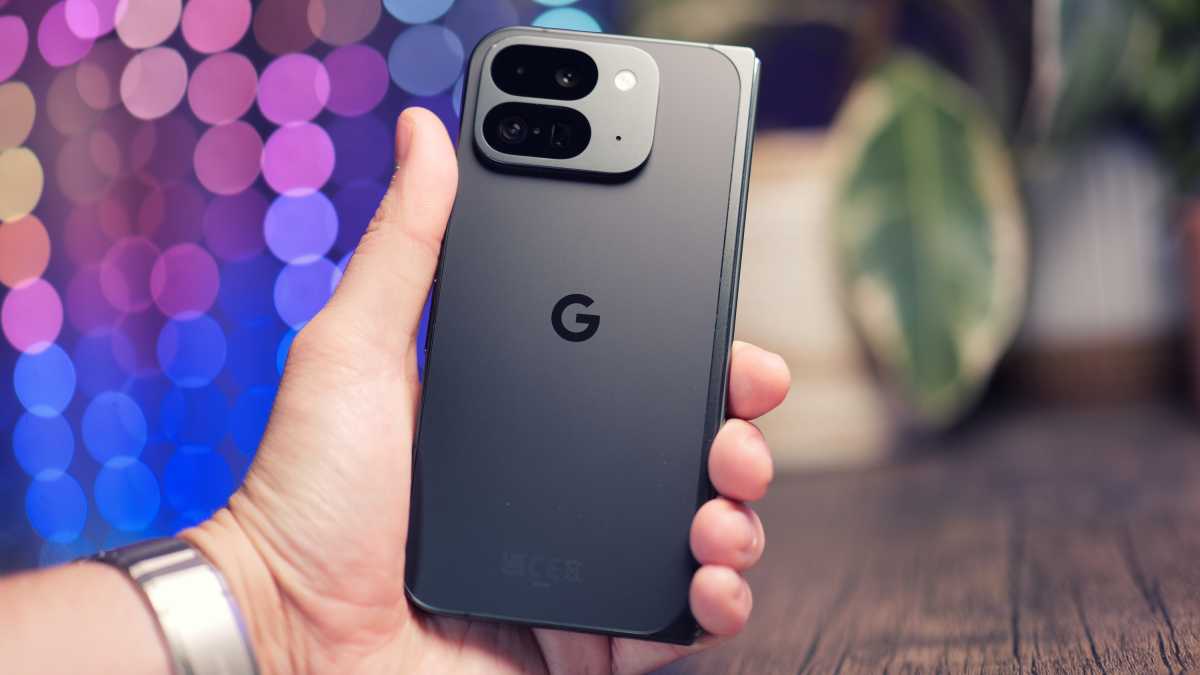
Luke Baker
It’s not the slimmest handset around, measuring just under 9mm thick when folded down, and it’s not the lightest either, at 257g. It’s still slimmer than the Z Fold 6, Samsung’s slimmest to date, but I moved into this phone directly after the Honor Magic V3, and it felt very chunky by comparison.
Part of this is due to the boxy, iPhone-like shape. It matches the rest of the Pixel 9 lineup, with flat side rails and flat displays, and I think it looks great. It’s almost exactly the same size as the regular Pixel 9 Pro when folded, just thicker, with a squared-off side for the hinge.
It’s almost exactly the same size as the regular Pixel 9 Pro when folded, just thicker, with a squared-off side for the hinge
This means that using the cover display feels extremely natural. You don’t lose any height like you did on the previous Pixel Fold, and you don’t have a cramped keyboard like you do with the more narrow Z Fold 6.
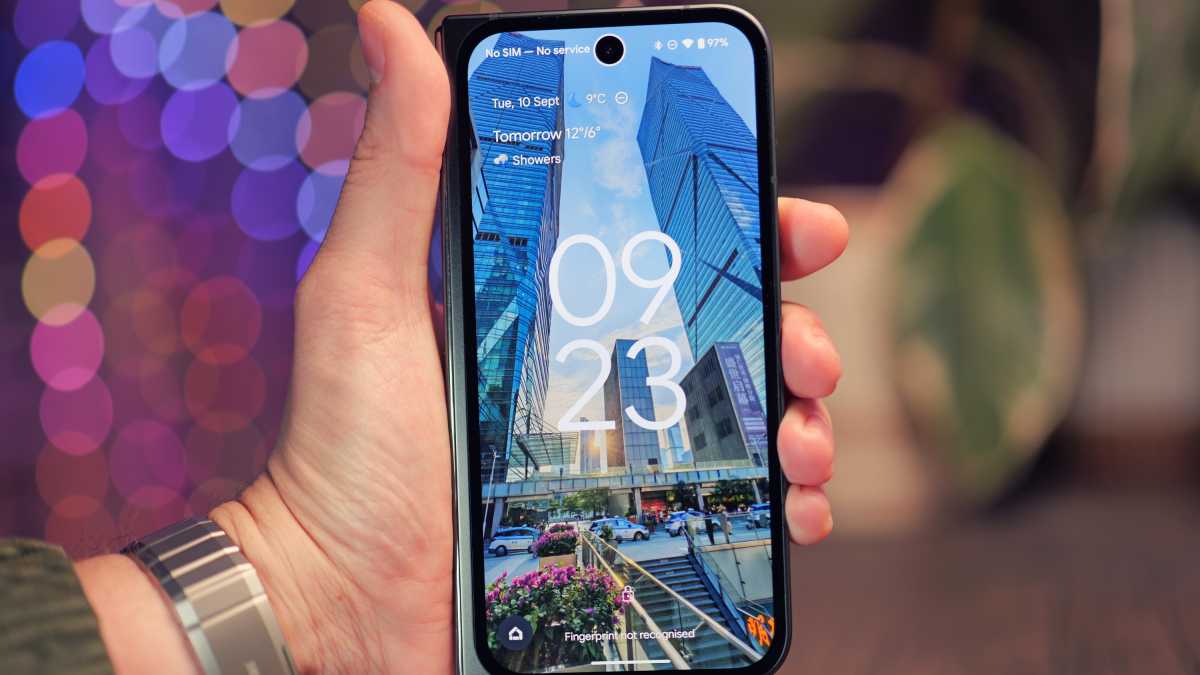
Luke Baker
Unlike the other Pixel 9 models, the Fold has a matt finish on its side rails, and I much prefer it. It’s much less fingerprint-prone and still very grippy. However, the hinge still has that high-gloss smudge magnet finish as you’ll find on the other phones.
Speaking of the hinge, it’s one of the most impressive that I’ve come across, only rivalled by Samsung. It can be adjusted to almost any angle without snapping open or shut. It’s great for when you’re trying to frame a photo in tripod mode, or watching YouTube in flex mode.
Around the back, you get a flat frosted matt rear panel in either Porcelain (off-white) or Obsidian (dark grey/black). The camera island is positioned at the top left, very similar to the older Pixel Fold, and it’s not an oblong bar shape like the rest of the Pixel family. It’s not as iconic, but I think it still looks rather fetching, and it’s wide enough not to introduce wobble when it’s placed on a desk.

Luke Baker
One thing I just couldn’t get used to on this phone is the positioning of the volume rocker. It’s really low down, so turning the volume down requires some serious thumb gymnastics when using the phone one-handed. Those with smaller hands may not have as much trouble, but I found it very annoying.
The haptics on this phone are fantastic, and among the best you’ll find on a foldable. The precise strong vibrations feel great when you’re typing quickly, and there’s a satisfying thunk when you toggle a setting on and off.
Screen & Speakers
- Cover: 6.3-inch, 1080 x 2424, 120Hz OLED, 2700 nits
- Main: 8-inch, 2076 x 2152, LTPO OLED, 1800 nits
- Stereo speakers
I’ve already touched on the cover display dimensions, but it’s worth repeating that this phone is almost identically sized to the Pixel 9 Pro. Unlike Samsung’s narrow cover display, using this one doesn’t feel like a compromised experience, and there are only a few tells that you aren’t dealing with a regular slab phone.
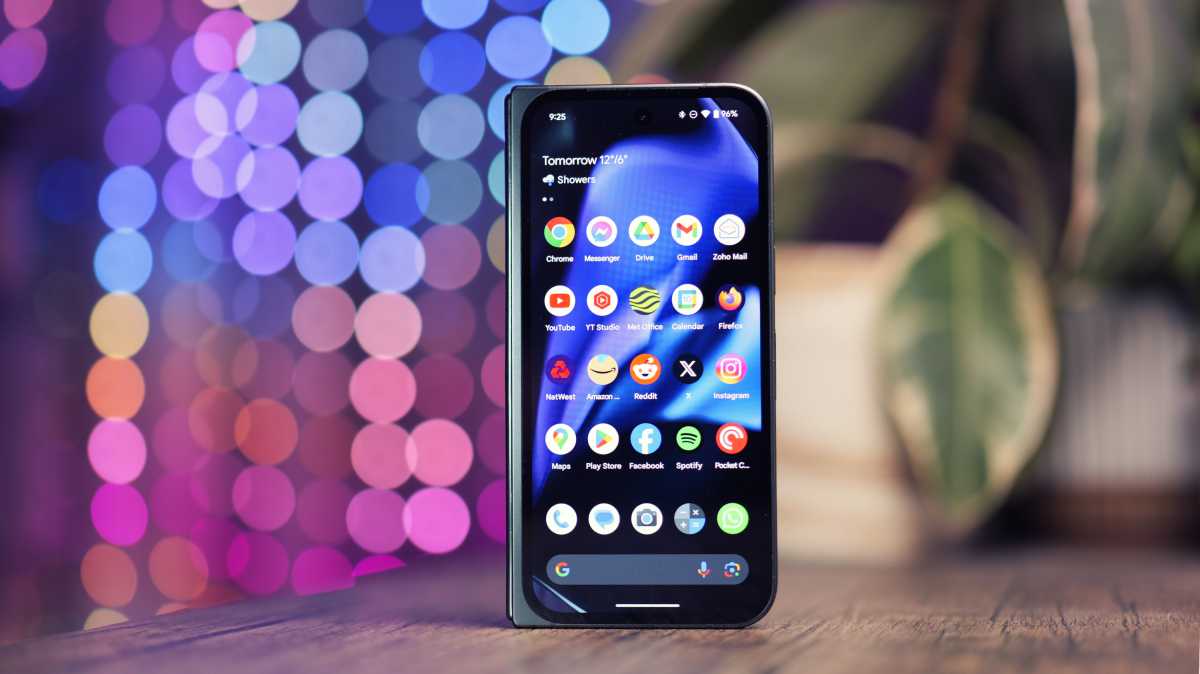
Luke Baker
Obviously, it’s a thicker and heavier phone, but the bezels on the cover display are also much chunkier. It’s not something that really bothered me in use, but it looks a little dated compared to the competition. It’s also not an LTPO panel, so the refresh rate only shifts between 60- and 120Hz. Again, it didn’t really bother me, but it’s an odd omission on the screen likely to get the most use.
Elsewhere, the cover display left me with no complaints. The 2700 nit peak brightness was more than enough to contend with direct sunlight, and a fully flat panel meant no phantom touches or weird reflections to deal with.
On the inside, there’s a massive 8-inch foldable display, and this one is an LTPO panel. It’s not quite as bright, peaking at 1800 nits, but I never had trouble seeing it in a wide variety of lighting conditions.
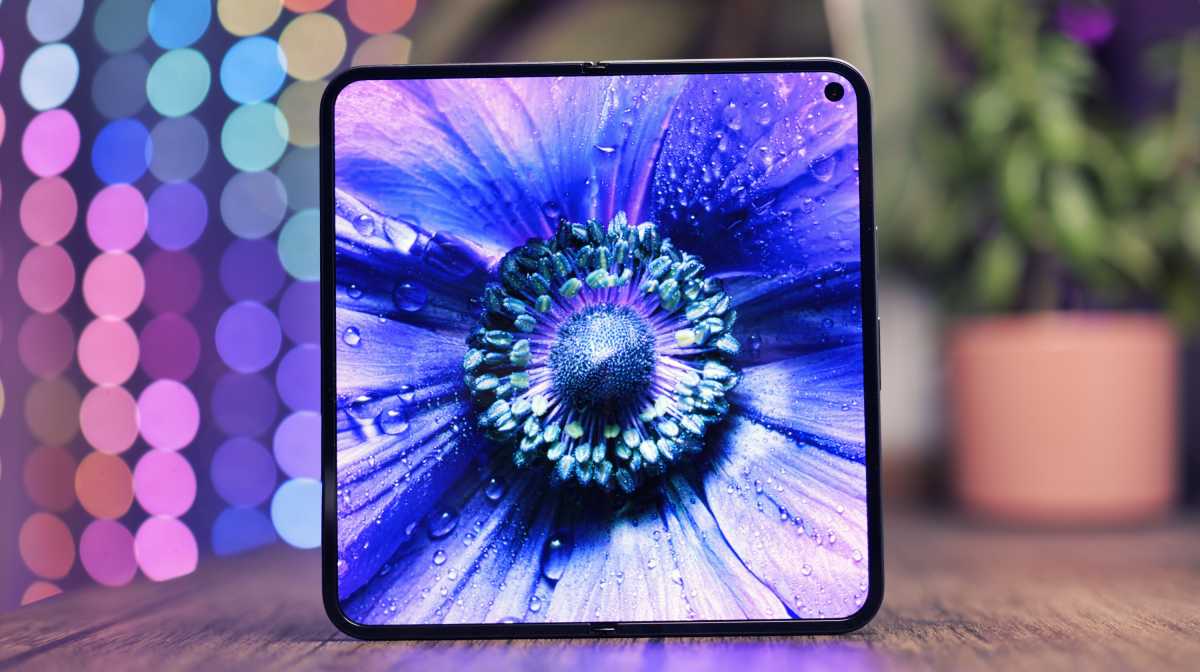
Luke Baker
Google claims the 9 Pro Fold has the biggest display on a foldable, and that might be true in the US market, but it’s not the case for those of us with access to handsets from Chinese manufacturers. It’s certainly larger than the Z Fold 6, but I found that the Honor Magic V3 and Vivo X Fold 3 Pro both have larger usable display space, due to the curvy corners and thicker bezels on the Pixel.
That said, it’s still a wonderfully spacious display that’s great for multitasking and watching full-screen content. I like that the selfie camera cut-out is tucked away in the corner, too, as it means it rarely interrupts full-screen videos. It’s a much more modern-looking solution than its chunky bezel-ed predecessor, and personally, I find it less distracting than Samsung’s low-res patch that covers the under-display selfie camera.
There’s still a pretty sizable crease and it’s more noticeable than some of its rivals due to a high-gloss screen protector
The Pixel 9 Pro Fold actually folds flat, which is an upgrade compared to the previous model, which liked to sit a slight V-shape. There’s still a pretty sizable crease and it’s more noticeable than some of its rivals due to a high-gloss screen protector. I do think it’s better than Samsung’s crease, but next to the Honor Magic V3, it’s not the most impressive.
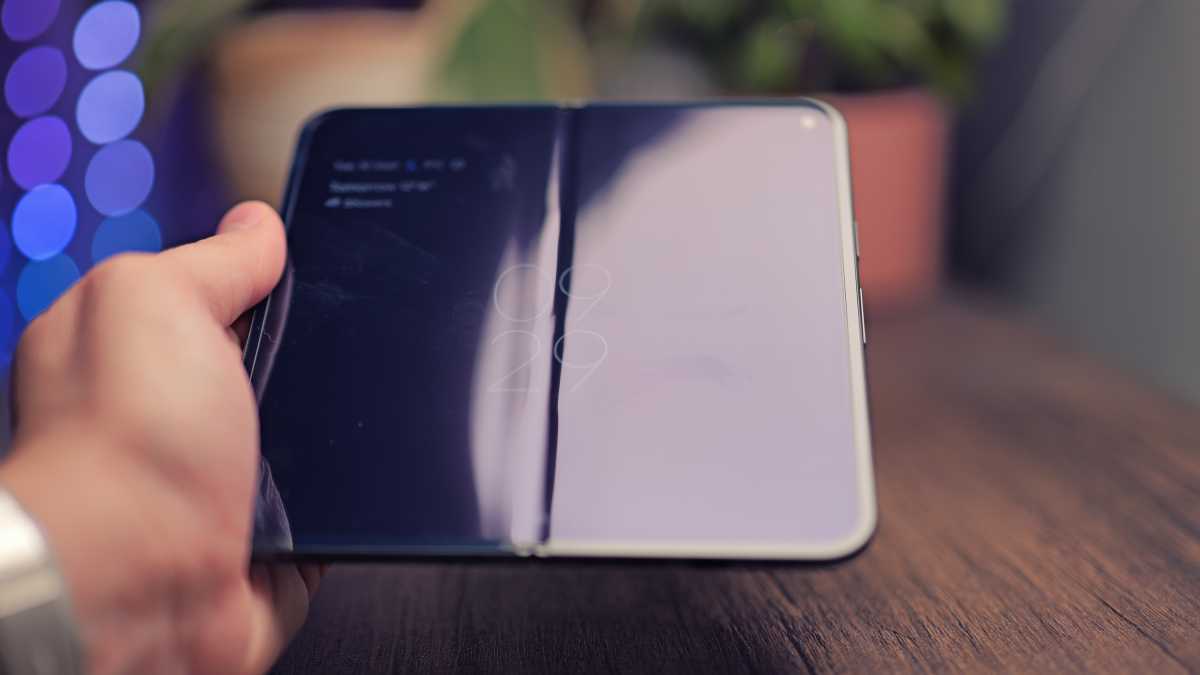
Luke Baker
The positioning of the speakers makes it feel like the phone is designed to be held in portrait orientation, with the fold running down the centre, whereas a lot of my other foldables encourage you to flip the phone into landscape mode. I say this because one speaker is almost always muffled by my palm in landscape mode, and the almost-square aspect ratio means that 16:9 content doesn’t get much larger when you rotate it. That’s fine by me, it’s much more convenient than spinning it around.
The speakers can get extremely loud and they sound superb, with more low-end response than your typical phone. They trade blows with the Z Fold 6 speakers, although Samsung often pulls ahead slightly with the bass frequencies.
Specs & Performance
- Google Tensor G4
- 16GB RAM
- 256GB / 512GB storage
The Pixel 9 Pro Fold runs on Google’s fourth-generation Tensor G4 chip, just like the rest of the Pixel 9 series. It’s well-documented at this point that this processor isn’t a massive upgrade over the last generation Tensor G3, at least outside of some very specific AI-based workloads.
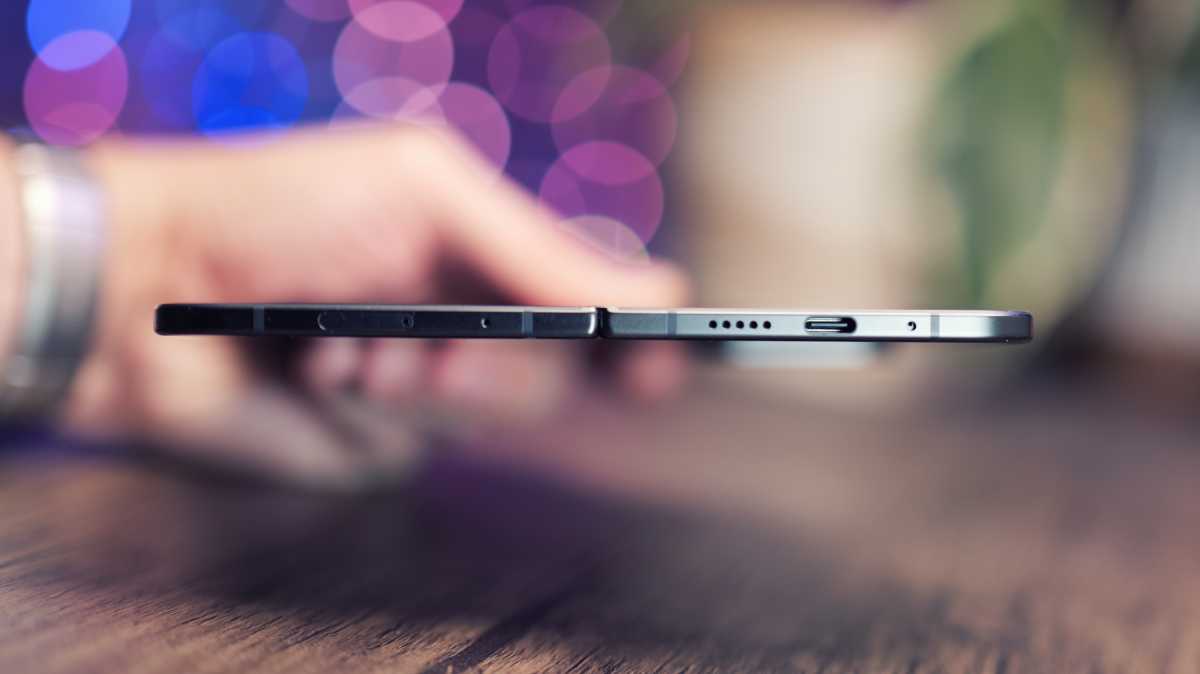
Luke Baker
It’s paired with a respectable 16GB of RAM and either 256GB or 512GB of storage. Thankfully, Google chose to forego the 128GB option on this model.
Going in with this knowledge, I wasn’t expecting too much in the performance department, but I was pleasantly surprised. In day-to-day use, scrolling social media, messaging and consuming content, the Pixel 9 Pro Fold feels lightning-quick.
In day-to-day use, scrolling social media, messaging and consuming content, the Pixel 9 Pro Fold feels lightning-quick
Whatever Google is doing to squeeze the most out of this chip is clearly working, and whether it’s a trick of the animation style or some clever optimisation, navigating the OS feels snappier and more responsive than the experience with most rival devices.
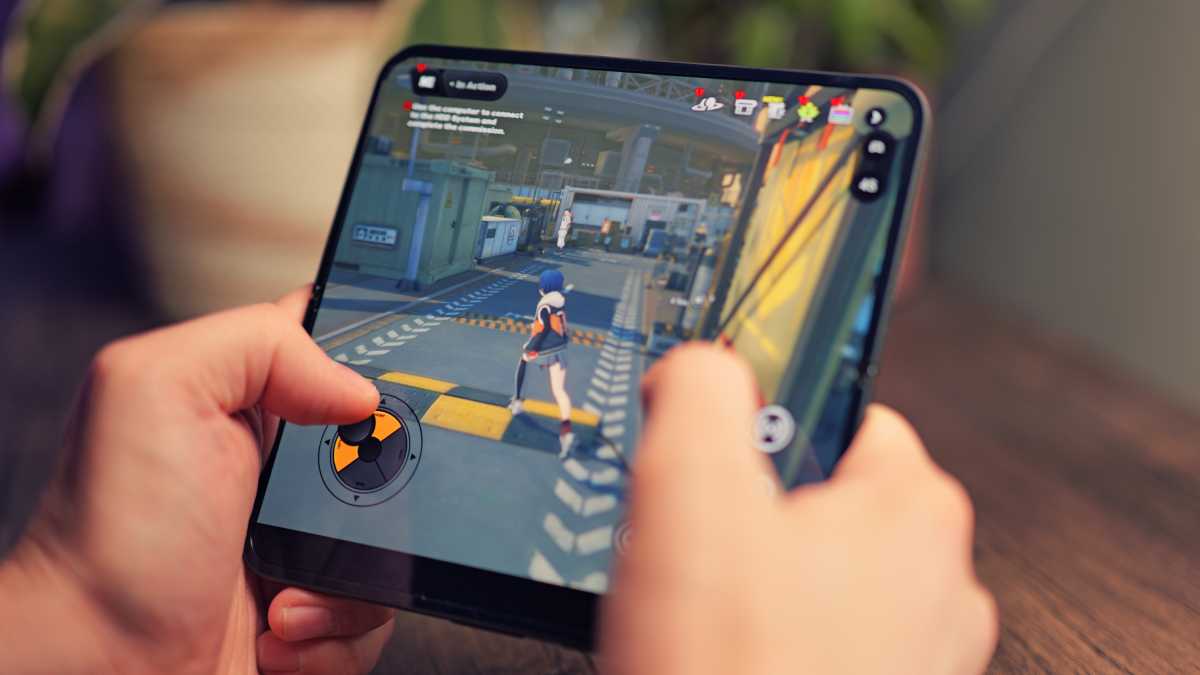
Luke Baker
In benchmarks, however, we can clearly see that Google is a few steps behind flagships with Qualcomm and its Snapdragon 8 Gen 3. For that reason, the Pixel 9 Pro Fold is unlikely to be the top choice for keen gamers.
That said, the device can still play games well, even graphically challenging ones. I found that Zenless Zone Zero would run fairly smoothly at 30fps with max graphic settings, however when I tried pushing it to 60fps there were plenty of frame drops and stutters to sour the experience.
I was also impressed by the thermal performance. It does get warm when playing GPU-heavy games, of course, but it never got too hot or uncomfortable to hold, which is all you can really ask for.
Google Pixel 9 Pro Fold benchmarks
Cameras
- 48Mp main camera
- 10.5Mp ultrawide
- 10.8Mp 5x periscope telephoto
- 10Mp selfie camera
Pixel phones are well known for their photographic capabilities, but in contrast to some other brands, most of the prowess comes from image processing, rather than cutting-edge hardware. In the case of the Pixel 9 Pro Fold, there are no hardware upgrades for the camera system, but that might not matter so much.
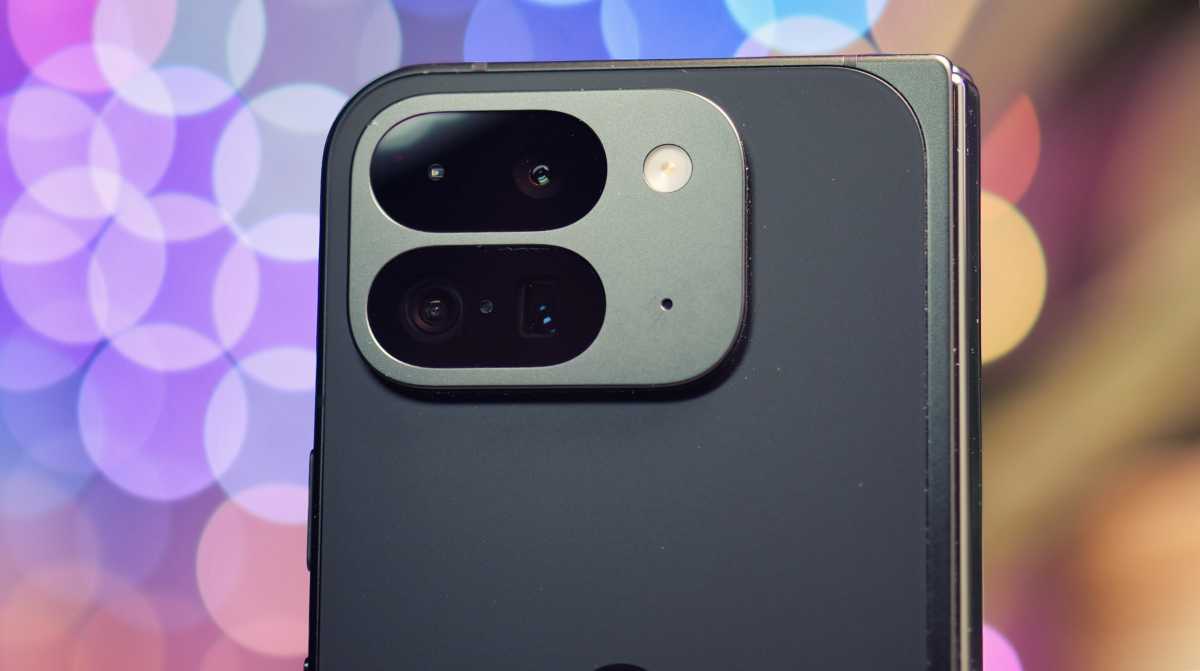
Luke Baker
Still, it means you have some very low-resolution sensors in the lineup. Only the main camera sports a 48Mp resolution, while the others all hover around the 10Mp mark. They’re all quite small sensors, too, especially when compared to Chinese brands like Honor and Vivo. This means the Pixel has to rely on night mode and noise reduction more heavily when shooting in low-light conditions.
In the day, images from the Pixel 9 Pro Fold have the signature Pixel charm – they look bright, sharp and detailed, with excellent dynamic range. It’s a slight step down in quality compared to the mainline Pixel snappers, but results are similar enough, and it’s just as reliable as a point-and-shoot camera for social media posts.
Images from the Pixel 9 Pro Fold have the signature Pixel charm – they look bright, sharp and detailed, with excellent dynamic range
When it gets darker, the main camera is the way to go. It produces the sharpest images with the most detail, meanwhile, the telephoto and ultrawide cameras look a little soft and are very prone to motion blur. I suspect the muddiness comes from over-active noise reduction, as in video mode, these sensors look quite grainy, but in photos, it all disappears.
There are two selfie cameras with identical specs, they’re both 10Mp punch-hole units and neither has autofocus. These cameras are good enough for video calls but I found them unimpressive for photos. Lots of my snaps came out looking washed-out, and low-light shots often looked blurry. The good news is that this is a foldable, so it’s just as easy to take selfies using the vastly superior main camera.
One thing I wish Google would spend some time improving is its portrait mode. It feels very limited on this phone, especially compared to the Honor Magic V3. It only works on the main camera, and it always applies at least a 1.5x crop to the image. There are no filters, no control over the amount of blur, and the subject detection is a little hit-and-miss.
One of the new Fold-exclusive features is something called “Made you look”. It uses the cover screen to display animated cartoon characters to attract the attention of babies and toddlers. I thought this was going to be a gimmick, but when I tried it with my friend’s kid, I was amazed.
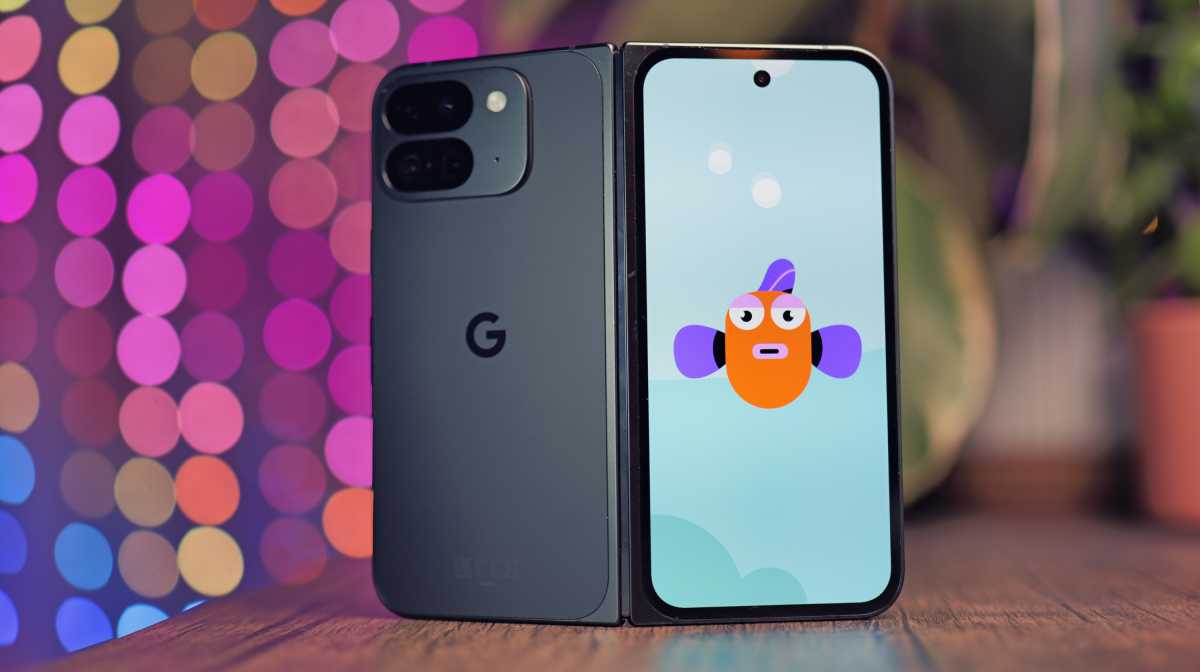
Luke Baker
The kid immediately stopped running around and was glued to the screen, making it super easy to grab some pictures. Unfortunately, that’s where I also realised this mode’s big shortcoming. It uses the cover screen selfie camera rather than the main camera. It makes sense, as that’s where the child will be looking, and that’s fine in the day, but I was in a dimly lit restaurant, so my photos were a blurry mess.
Of course, you get all the other Pixel-exclusive photo features on this phone, too, including the new Add Me feature, along with post-processing tweaks like Best Take, Photo Unblur and Super Res Zoom.
Add Me seems to work just as well on this phone as it does on the other Pixels, but I can’t help but feel it’s a bit over-complicated. After all, it seems much easier to snap a group selfie, ask a stranger to take a picture or use the phone’s own built-in tripod mode. If you fancy cloning yourself, though, this is an easy way to do so.
Battery Life & Charging
- 4650mAh battery
- 21W charging
- 7.5W wireless charging
The Pixel 9 Pro Fold houses a 4650 mAh battery pack, just managing to outdo the chunkier Galaxy Z Fold 6’s 4400 mAh capacity. But with larger and brighter screens on board, will that result in better real-world battery life?
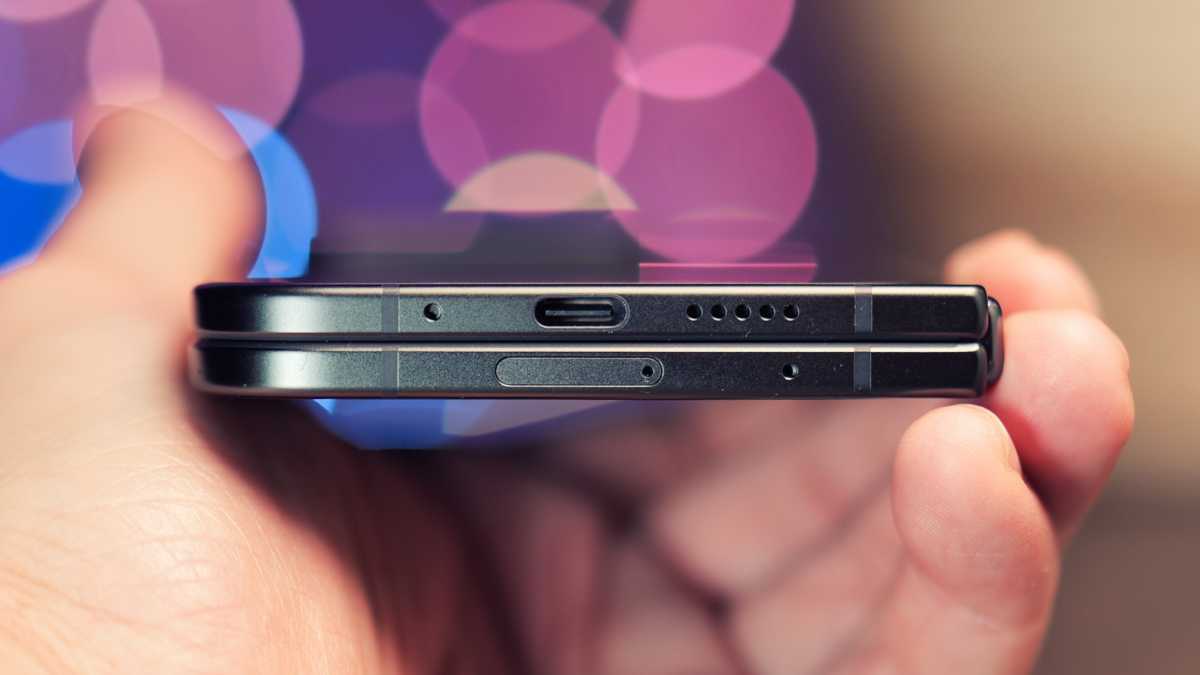
Luke Baker
In my experience, yes, but only slightly. An average day saw me going to bed with around 20-30% left in the tank, but when I spent an hour or so gaming or took lots of photos, that figure was significantly reduced. Throughout my testing, I never needed a mid-day top-up, but expect to charge every night without fail.
An average day saw me going to bed with around 20-30% left in the tank
There’s no charger included in the box, just a USB-C cable, and the charging speeds are truly underwhelming. I’ve spent plenty of time moaning about the Z Fold 6′s sluggish charging, but somehow the Pixel 9 Pro Fold manages to be even slower, maxing out at a measly 21W with a wire and just 7.5W wirelessly.
In real-world terms, that means a 50% charge will take just over half an hour, while a full charge is likely to take around an hour and 40 minutes. On the plus side, the OS has battery health measures built-in, meaning you can leave it plugged in overnight without fear.
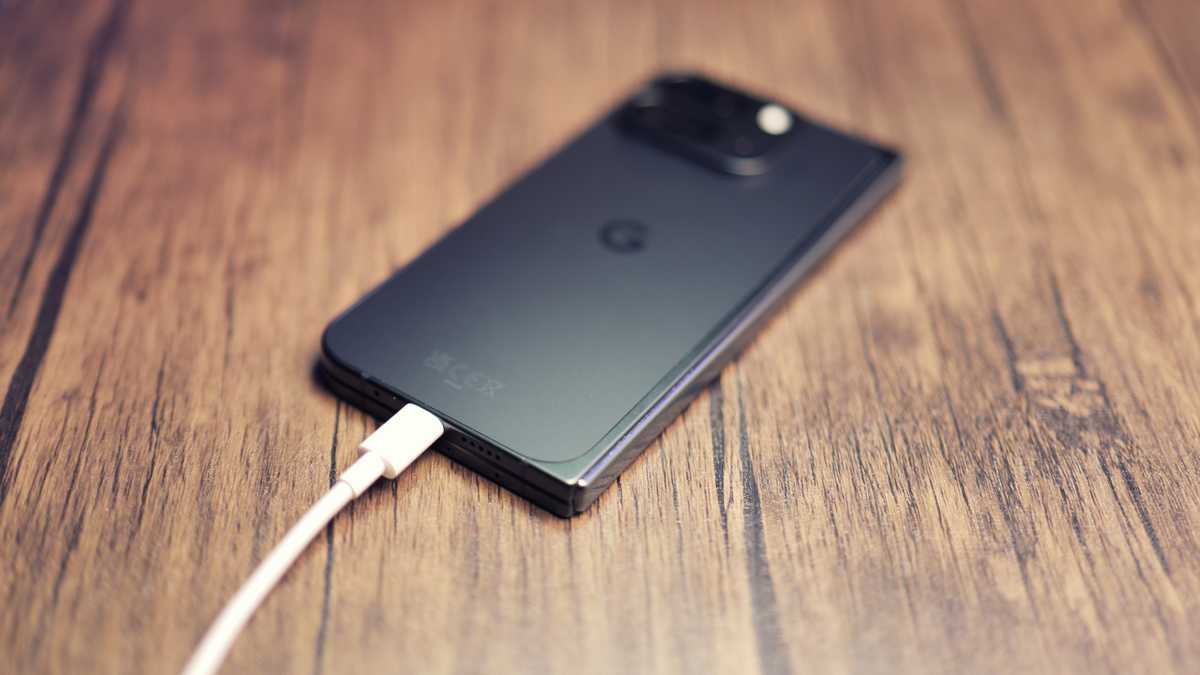
Luke Baker
Software & Apps
- Android 14
- Gemini AI features
- New Screenshots, Weather and Pixel Studio apps
Like the rest of this year’s Pixel lineup, the Pixel 9 Pro Fold launched in advance of Android 15, so it’s running Android 14 instead. However, that doesn’t mean there’s nothing new here, on the contrary, Google has added three new first-party apps, as well as a slew of extra AI-powered enhancements.
Most of what you’ll find here is identical to the other Pixel 9-series devices, and Pixel 8 models, too. With this being a large-format foldable, though, the multitasking experience is much more important.
For the most part, I like the way Google has approached this. It’s quick and easy to understand the split screen mode, and it’s simple to set up your most common app pairings, too.
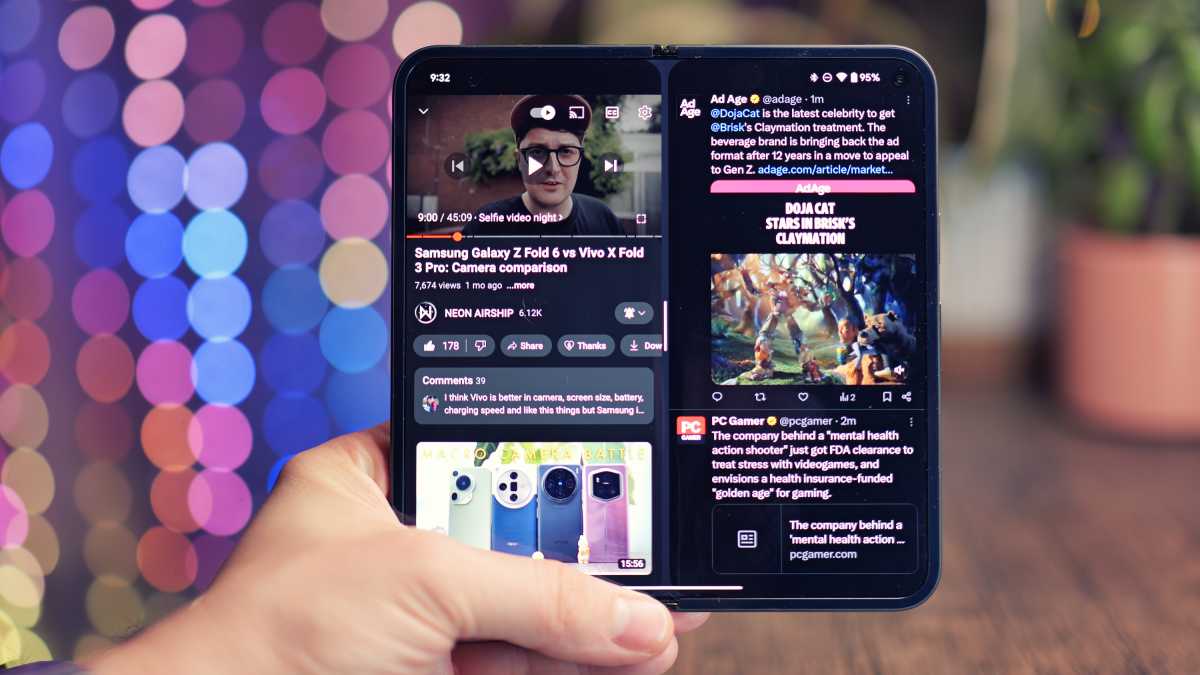
Luke Baker
The problem is that it’s slightly too simplistic. With no support for floating windows, you’re stuck with a maximum of two apps side-by-side in split-screen mode. Other brands are doing more here, and Google needs to step its game up if it wants the Fold to be a true productivity powerhouse.
Otherwise, I like the Pixel UI. It’s completely free from bloatware, it feels quick and responsive, and there are nice quality-of-life features built in. I love the Now Playing feature that lets you know what music is playing on your lock screen, the integration with Google Home is excellent, too. On the flip side, there are some very basic features that the Pixel interface is still lacking, like the ability to move apps around in bulk.
Google spent a lot of the Pixel 9 launch event talking about its new Gemini-powered AI features, and some of them are really impressive. At times, talking to Gemini Live feels like a glimpse into the future – but the problem is, it’s not a Pixel feature.
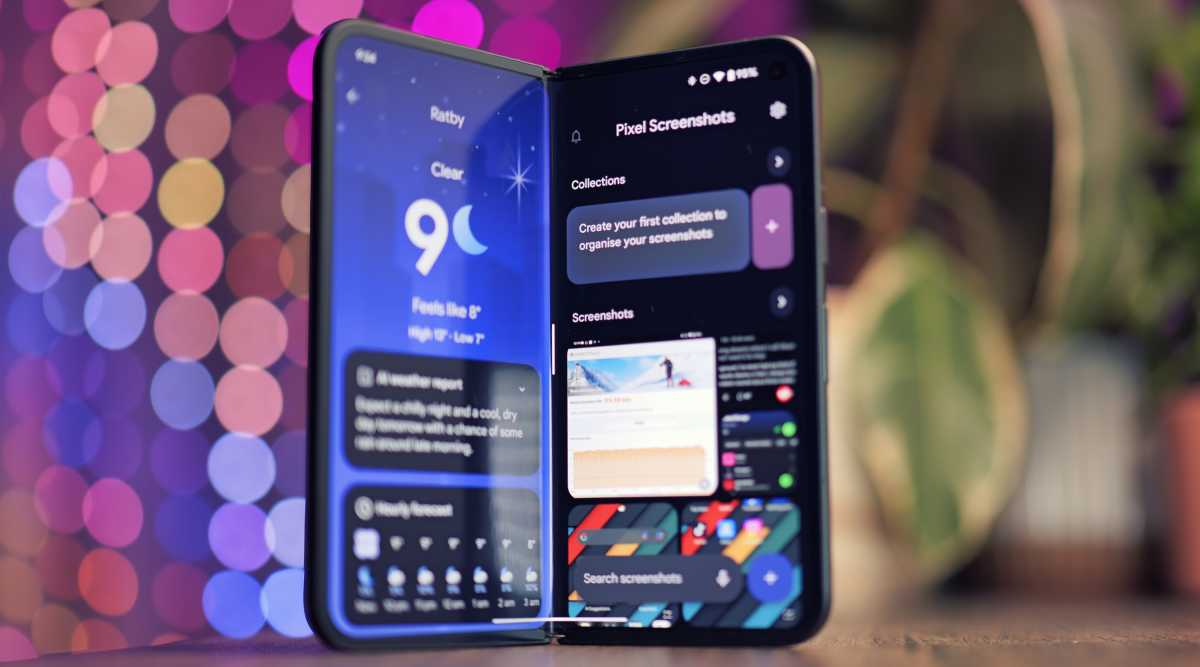
Luke Baker
I can do the same thing on most other Android phones, and I have. Pixel owners get a 1-year free trial of Gemini Advanced to try it, but once it’s up, Google’s asking for a £18.99/$20 per month subscription that I’m sure most can do without.
The three new apps have varying degrees of usefulness, and I’m a little miffed about them being separate apps. For instance, I think the Screenshots app is quite useful, but I don’t see why it couldn’t be integrated into Google Photos. The same goes for the new Weather app, which is very pretty, but I already have a weather app that I like, and I don’t need an extra non-deleteable version.
One thing that I do love is Circle to Search. It’s nothing new, we’ve seen it on all of this year’s Samsung flagships and Google devices, but it’s great and I miss it when it’s not there.
Another big selling point is the seven years of both OS and security updates that Google offers. It’s not the only foldable with this promise – the Galaxy Z Fold 6 has identical support – but still very impressive.
Price & Availability
The Google Pixel 9 Pro Fold is available to purchase now in most regions across the globe. If you buy it outright, the 256GB model will cost you £1,749/ $1,799 while the 512GB model goes for £1,869/$1,919. It’s certainly not cheap, but this is a large format foldable, and this kind of pricing comes with the territory.
If you’re paying upfront, you can grab the phone from the Google Store in UK and US, as well as Amazon UK and Amazon US. Of course, there are plenty of contract deals that can help to spread the cost.
We’ve rounded up both in our best Pixel 9 deals article, but more contract options are available below:
Should you buy the Google Pixel 9 Pro Fold?
I’ve loved living with the Pixel 9 Pro Fold, it’s such a vast improvement on the previous model and one of the most polished and premium-feeling foldable handsets on the market today. Despite having a slower processor and fewer software features, I still prefer it over the Galaxy Z Fold 6. If we’re only talking about phones that you can buy in the US, then it’s extremely easy to recommend.
In the UK, however, Honor has the Magic V3, which bests the Pixel in almost every area and comes at a lower cost. Sure, its AI features may not be quite as advanced, but I found the camera more impressive, it’s quicker, has a bigger battery, faster charging and more storage – all for about £100 less.
That said, the Pixel does have its charms, and if you love the bloat-free Pixel experience, the Honor device is no substitute. It has a longer support term and will be one of the first devices to get all the goodies that come with Android 15, too. It might not be the best hardware available, but it’s still one of the best folding phones.
Specs
- Android 14
- Cover: 6.3-inch, 1080 x 2424, OLED, 120Hz
- Main: 8-inch, 2076 x 2152, LTPO OLED, 120Hz
- Side-mounted fingerprint sensor
- Google Tensor G4
- 16GB RAM
- 256GB / 512GB storage
- Cameras:
- 48Mp main camera
- 10.5Mp ultrawide
- 10.8Mp 5x periscope telephoto
- 2x 10Mp selfie cameras
- Up to 4K @ 60fps rear video
- Stereo speakers
- Dual-SIM + eSIM
- Wi-Fi 802.11 a/b/g/n/ac/ax/be
- Bluetooth 5.3
- 4650mAh battery
- 21W charging
- 7.5W wireless charging
- 155.2 x 77.1 x 10.5 mm (folded)
- IPX8 certified
- 257g
- Colours: Porcelain, Obsidian



